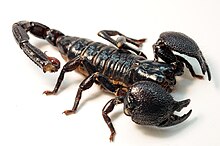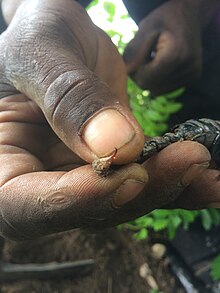Emperor scorpion
| Emperor scorpion | |
|---|---|

| |
| Scientific classification | |
| Domain: | Eukaryota |
| Kingdom: | Animalia |
| Phylum: | Arthropoda |
| Subphylum: | Chelicerata |
| Class: | Arachnida |
| Order: | Scorpiones |
| Family: | Scorpionidae |
| Genus: | Pandinus |
| Species: | P. imperator
|
| Binomial name | |
| Pandinus imperator (Koch, 1842)
| |

The emperor scorpion, Pandinus imperator, is a
Description

The emperor scorpion (Pandinus imperator) is one of the largest species of scorpion in the world, with adults averaging about 20 centimetres (7.9 in) in length and a weight of 30 g.
When gravid (pregnant), the body of a female expands to expose the whitish membranes connecting the segments. The emperor scorpion fluoresces greenish-blue under
They are known for their docile behavior and almost harmless sting; they do not use their sting to defend themselves when they are adults, however, they may use it in their adolescent stages. They prefer to use their pincers to crush and dismember their prey. Their exoskeleton is very sclerotic, causing them to have a metallic greenish-black color.
Emperor scorpions are often confused with a similar genus (Heterometrus), and are one of the most famous scorpions.
Different ion channel toxins have been isolated from the venom of the emperor scorpion, including Pi1,[8] Pi2,[9][10] Pi3,[9] Pi4[11] and Pi7.[12]
Habitat and distribution
The emperor scorpion is an African rainforest species,
This species inhabits both
Feeding habits
In the wild, emperor scorpions primarily consume insects and other terrestrial invertebrates, although termites constitute a large portion of their diet. Larger vertebrates, such as rodents and lizards, are occasionally eaten. Emperor scorpions will burrow through termite mounds up to 6 feet deep in order to hunt prey. Their large claws help in tearing apart prey while their tail stinger injects venom at the same time for liquifying food. Juveniles rely on their venomous sting to paralyze prey while adults use their large claws to tear apart prey.
Conservation and human impact
-
Young female emperor scorpion kept as a pet
-
P. imperator is very docile and tolerant of human contact.
African emperor scorpion venom contains the toxins imperatoxin[15] and pandinotoxin.
Due to its docile nature, large size, and hardiness, P. imperator is a popular scorpion in the pet trade, which has led to such over-collecting in the wild that it is now a CITES-listed animal.[1] They feed readily on crickets and worms available to keepers, and they can live up to 8 years in captivity.
References
- ^ UNEP-WCMC. "Pandinus imperator (Koch, 1841)". UNEP-WCMC Species Database: CITES-Listed Species. Archived from the originalon 7 August 2011. Retrieved 11 June 2011.
- ^ ARKive
- ISBN 978-0-7641-1224-9.
The emperor scorpion can reach an overall length of more than 8 inches (20 cm). It is erroneously claimed to be the largest living scorpion in the world. However, some species of Forest Scorpions are its equal. [...] Emperor scorpions have the same venom as a bee.The Guinness Book of Records claims a Forest Scorpion native to rural India, Heterometrus swammerdami, to be the largest scorpion in the world (9 inches [23 cm]).
- ^ "Scorpion Emperor Care Sheet" (PDF). Petco. 2004. Archived from the original (PDF) on 2009-07-11. Retrieved 2012-03-24.
- ^ a b "Emperor Scorpion". The Animal Information Centre. March 2005. Archived from the original on 2013-09-21. Retrieved 2011-09-15.
- ^ "Emperor Scorpion". The Big Zoo. March 2005. Archived from the original on 2011-08-04.
- ^ a b Emperor scorpion media from ARKive Accessed October 20, 2011.
- PMID 8645186.
- ^ S2CID 20551964.
- PMID 10707030.
- PMID 9655636.
- PMID 10606507.
- ISBN 978-0-262-16137-4.
- ^ "Scorpion Systematics Research Group". American Museum of Natural History. November 2008. Retrieved October 20, 2011.
- PMID 9115249.
External links
 Media related to Pandinus imperator at Wikimedia Commons
Media related to Pandinus imperator at Wikimedia Commons


